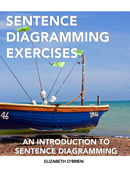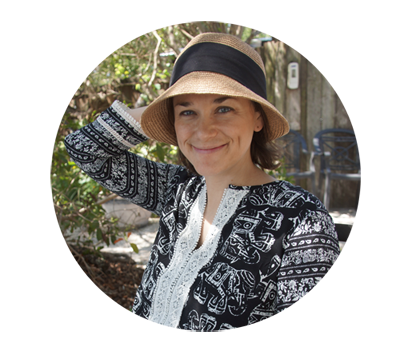Chapter 11: Diagramming Verbals (Gerunds, Participles, & Infinitives)
Chapter 11: Diagramming Verbals
(Gerunds, Participles, & Infinitives)
- Home
- How to Diagram
- Diagramming Verbals
Do you know what verbals are? They are words that are formed from verbs but don't act as verbs. There are three types. Let's look briefly at what they are, and then we'll explore each one more and see how to diagram them!
1. Gerunds end with -ing and function as nouns.
Running is my favorite sport.
2. Participles end in -ing, -d, -t, or-n, and they act as adjectives.
I hear running water.
3. Infinitives consist of the word to + a verb, and they act as nouns, adjectives, or adverbs.
I love to run.
Are you ready to diagram? You can do this! The answers are at the bottom of the page.
11.0 Diagramming Gerunds
Remember that these verbals end with ing and act like nouns. They can function as subjects, direct objects, indirect objects, objects of prepositions, and more. When we diagram gerunds, we put them on steps. We put the ing part on the lower part of the step and the rest of the verb on the upper part of the step.
We attach the step to the slot in the diagram that corresponds to the gerund's function. For example, the following sentence has a gerund functioning as the subject.
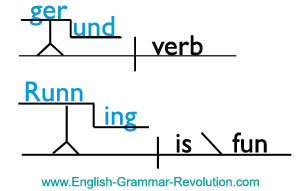
Running is fun.
Running is a gerund. It is formed from the verb run, it ends in ing, and it is functioning as a noun. It is the subject of the sentence.
Gerund Phrases
Gerunds can also take complements (direct objects, predicate nouns…) and modifiers (adjectives, adverbs…).
Gerunds plus their complements and/or modifiers are called gerund phrases.
Running marathons is fun.
Running marathons is a gerund phrase. It's made up of the gerund running and the direct object marathons.
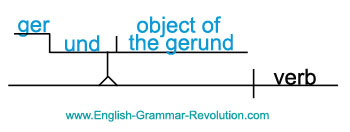
Directions: Diagram the following sentences. Place the gerund on a line that is drawn like a step. The ing part of the gerund goes on the bottom part of the step, and the rest goes on the top part of the step.
With a forked line, connect the step to the rest of the sentence wherever it should go. (Since gerunds are nouns, they can be the subject, direct object, object of the preposition, or predicate noun.)
1. My sister and I enjoy laughing.
2. Wow! Riding my bike is really fun.
3. Jumping rope for twenty minutes is good for your heart.
4. My favorite game is throwing frisbees to my dog.
5. I dream of diving to the bottom of the ocean.
1.1 Diagramming Participles
Remember that these verbals end in ing, d, t, or n, and they act as adjectives. That means that they can modify any noun or pronoun.
We diagram them on a curved, slanted line under the noun or pronoun that they are modifying.
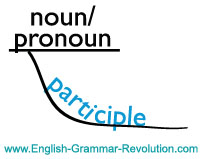
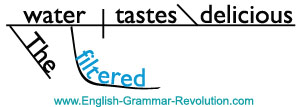
The filtered water tastes delicious.
Filtered is a participle. It is formed from the verb filter, it ends in d, and it is functioning as an adjective modifying the noun water.
Participial Phrases
Participles can also take complements and modifiers. Participles plus their complements and/or modifiers are called participial phrases.
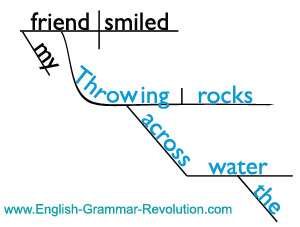
Throwing rocks across the water, my friend smiled.
Throwing rocks across the water is a participial phrase. It contains the participle throwing along with the direct object rocks and the prepositional phrase across the water. The whole phrase is functioning as an adjective modifying the noun friend.
Directions: Diagram the following sentences. Place the participles on a curved line below the word that it modifies.
1. Have you seen my biking shorts?
2. Yuck! I hate burned toast.
3. I threw the ball to the girl running across the field.
4. The plants growing near the window need water.
5. The filtered water tastes delicious.
11.2 Diagramming Infinitives
These verbals are formed from the words to + a verb, and they can act as nouns, adjectives, or adverbs.
Diagramming Infinitives as Nouns & Adverbs
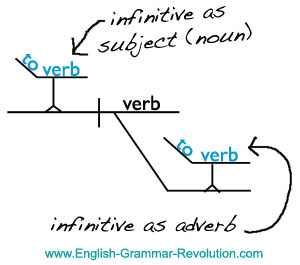
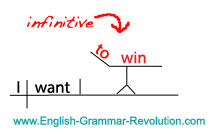
I want to win.
To win is an infinitive. It is formed from the verb win, it's made of the words to + a verb, and it is acting as a noun. It is the direct object of the verb want.
Infinitive Phrases
Infinitives can also take complements and modifiers. Infinitives plus their complements and/or modifiers are called infinitive phrases.

I want to win the game.
To win the game is an infinitive phrase. It is formed from the infinitive to win and the direct object game. The whole phrase is functioning as a noun. It is the direct object of the verb want.
Directions: Diagram the following sentences. Place the word to on an angled line, and write the verb on a horizontal line coming off the angled line.
With a forked line, connect this to the rest of the sentence wherever it should go. (Infinitives can be nouns, adjectives, or adverbs.)
1. My dog loves to bark at cars.
2. To master a new skill takes patience and persistence.
3. Jessica entered the race to win.
4. My goal is to live happily!
5. The puppies barked to get my attention.
Diagramming Verbals - Check Your Answers
11.0 Diagramming Gerunds
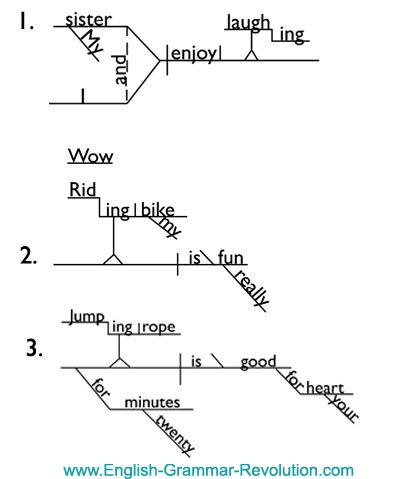
4. This answer is only available in the Sentence Diagramming Exercises Ebook
5. This answer is only available in the Sentence Diagramming Exercises Ebook.
Would you like to download these sentence diagramming exercises?
11.1 Diagramming Participles
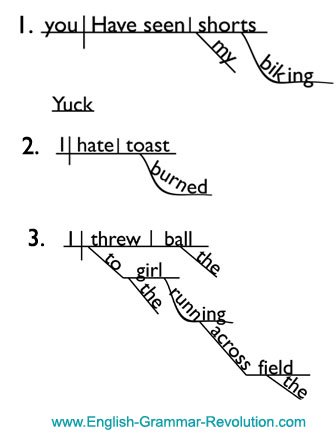
4. This answer is only available in the Sentence Diagramming Exercises Ebook.
5. This answer is only available in the Sentence Diagramming Exercises Ebook.
Would you like to download these sentence diagramming exercises?
11.2 Diagramming Infinitives
Get these answers in the ebook!
Would you like to download these sentence diagramming exercises?
I really want to thank you for all of your help! I'm learning so much that I'm smiling and feeling confident in myself now. I'm beginning to believe that anything is possible.
- Regina
Our Free Guide Gives You A Fun Way
To Teach And Learn The Basics v

Elizabeth O'Brien is the creator of Grammar Revolution.
Her lessons are guaranteed to give you more confidence in your communication skills and make you smile. :)
